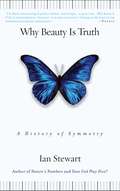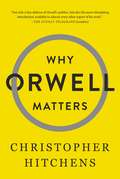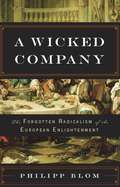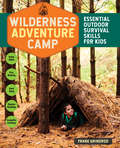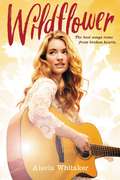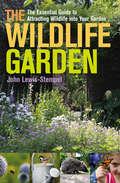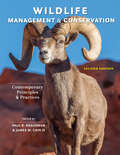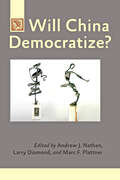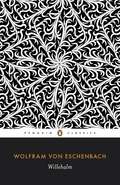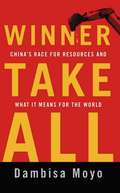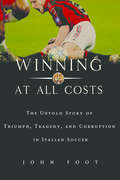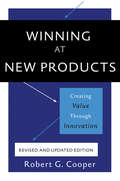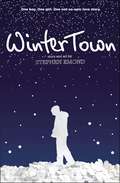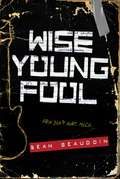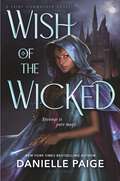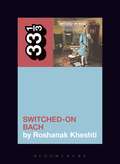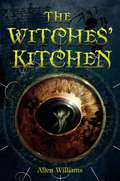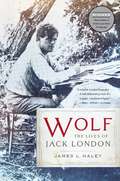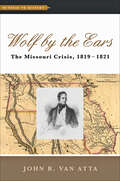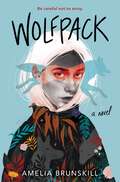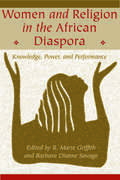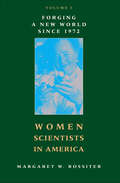- Table View
- List View
Why Beauty Is Truth: The History of Symmetry
by Ian StewartAt the heart of relativity theory, quantum mechanics, string theory, and much of modern cosmology lies one concept: symmetry. In Why Beauty Is Truth, world-famous mathematician Ian Stewart narrates the history of the emergence of this remarkable area of study. Stewart introduces us to such characters as the Renaissance Italian genius, rogue, scholar, and gambler Girolamo Cardano, who stole the modern method of solving cubic equations and published it in the first important book on algebra, and the young revolutionary Evariste Galois, who refashioned the whole of mathematics and founded the field of group theory only to die in a pointless duel over a woman before his work was published. Stewart also explores the strange numerology of real mathematics, in which particular numbers have unique and unpredictable properties related to symmetry. He shows how Wilhelm Killing discovered "Lie groups” with 14, 52, 78, 133, and 248 dimensions-groups whose very existence is a profound puzzle. Finally, Stewart describes the world beyond superstrings: the "octonionic” symmetries that may explain the very existence of the universe.
Why Beauty Is Truth: The History of Symmetry
by Ian StewartAt the heart of relativity theory, quantum mechanics, string theory, and much of modern cosmology lies one concept: symmetry. In Why Beauty Is Truth, world-famous mathematician Ian Stewart narrates the history of the emergence of this remarkable area of study. Stewart introduces us to such characters as the Renaissance Italian genius, rogue, scholar, and gambler Girolamo Cardano, who stole the modern method of solving cubic equations and published it in the first important book on algebra, and the young revolutionary Evariste Galois, who refashioned the whole of mathematics and founded the field of group theory only to die in a pointless duel over a woman before his work was published. Stewart also explores the strange numerology of real mathematics, in which particular numbers have unique and unpredictable properties related to symmetry. He shows how Wilhelm Killing discovered "Lie groups" with 14, 52, 78, 133, and 248 dimensions-groups whose very existence is a profound puzzle. Finally, Stewart describes the world beyond superstrings: the "octonionic" symmetries that may explain the very existence of the universe.
Why Orwell Matters
by Christopher Hitchens"Hitchens presents a George Orwell fit for the twenty-first century." --Boston GlobeIn this widely acclaimed biographical essay, the masterful polemicist Christopher Hitchens assesses the life, the achievements, and the myth of the great political writer and participant George Orwell. True to his contrarian style, Hitchens is both admiring and aggressive, sympathetic yet critical, taking true measure of his subject as hero and problem. Answering both the detractors and the false claimants, Hitchens tears down the façade of sainthood erected by the hagiographers and rebuts the critics point by point. He examines Orwell and his perspectives on fascism, empire, feminism, and Englishness, as well as his outlook on America, a country and culture toward which he exhibited much ambivalence. Whether thinking about empires or dictators, race or class, nationalism or popular culture, Orwell's moral outlook remains indispensable in a world that has undergone vast changes in the seven decades since his death. Combining the best of Hitchens' polemical punch and intellectual elegance in a tightly woven and subtle argument, this book addresses not only why Orwell matters today, but how he will continue to matter in a future, uncertain world.
A Wicked Company: The Forgotten Radicalism of the European Enlightenment
by Philipp BlomThe flourishing of radical philosophy in Baron Thierry Holbach's Paris salon from the 1750s to the 1770s stands as a seminal event in Western history. Holbach's house was an international epicenter of revolutionary ideas and intellectual daring, bringing together such original minds as Denis Diderot, Laurence Sterne, David Hume, Adam Smith, Ferdinando Galiani, Horace Walpole, Benjamin Franklin, Guillaume Raynal, and Jean-Jacques Rousseau.In A Wicked Company, acclaimed historian Philipp Blom retraces the fortunes of this exceptional group of friends. All brilliant minds, full of wit, courage, and insight, their thinking created a different and radical French Enlightenment based on atheism, passion, reason, and truly humanist thinking. A startlingly relevant work of narrative history, A Wicked Company forces us to confront with new eyes the foundational debates about modern society and its future.
Wilderness Adventure Camp: Essential Outdoor Survival Skills for Kids
by Frank GrindrodThis hands-on guidebook teaches kids aged 10 and up essential outdoor camping and survival skills, with step-by-step photos for how to build a fire, pick a campsite, make a lean-to, use a knife, cook over an open fire, and more.
Wildflower (Wildflower #1)
by Alecia WhitakerThe best songs come from broken hearts.Bird Barrett has grown up on the road, singing backup in her family's bluegrass band and playing everywhere from Nashville, Tennessee, to Nowhere, Oklahoma. But one fateful night, when Bird fills in for her dad by singing lead, a scout in the audience offers her a spotlight all her own.Soon Bird is caught up in a whirlwind of songwriting meetings, recording sessions, and music-video shoots. Her first single hits the top twenty, and suddenly fans and paparazzi are around every corner. She's even caught the eye of her longtime crush, fellow roving musician Adam Dean. With Bird's star on the rise, though, the rest of her life falls into chaos as tradition and ambition collide. Can Bird break out while staying true to her roots?In a world of glamour and gold records, a young country music star finds her voice.
The Wildlife Garden
by John Lewis-StempelWith the erosion of native wildlife habitats, gardens increasingly provide an invaluable source of food and shelter for Britain's fauna and flora. The Wildlife Garden is the essential guide to attracting birds to your bushes, butterflies to your buddleia and a whole array of other creatures into your garden - even if you only have a window box. Whether you just want to make an existing family space more wildlife friendly or go the whole hedgehog and turn your back garden into a mini nature reserve The Wildlife Garden will show you how to do it. There is full information on what plants are best for wildlife, on how to make refuges for insects and homes for bats, on making a pool for frogs, all whilst adding scent and colour to your surroundings.
Wildlife Management and Conservation: Contemporary Principles and Practices
by Paul R. Krausman And James W. Cain IIIThe definitive textbook for students of wildlife management, now updated to cover the latest techniques, tools, and topics.Wildlife Management and Conservation presents a clear overview of the management and conservation of animals, their habitats, and how people influence both. The relationship among these three components of wildlife management is explained in chapters written by leading experts and is designed to prepare students for careers in which they will be charged with maintaining healthy animal populations. To be successful wildlife professionals, they will need to find ways to restore depleted populations, reduce overabundant, introduced, or pest species, and manage relationships among various human stakeholders. This book gives them the basic knowledge necessary to accomplish these goals.This second edition, which is updated throughout, features several new and expanded topics, including communication in the wildlife profession, fire science, Indigenous models of management and conservation, plant–animal interactions, quantitative analysis of wildlife populations, and a detailed glossary. The book also covers:• Human dimensions of wildlife management• Animal behavior• Predator–prey relationships• Structured decision making• Issues of scale in wildlife management• Wildlife health• Historical context of wildlife management and conservation• Hunting and trapping• Nongame species• Nutrition ecology• Water management• Climate change• Conservation planningThe most widely used foundational text in the field, this is the perfect resource not only for students but also for early career professionals and those in related fields who need to understand the core tenets and tools of wildlife conservation and management.Contributors: C. Jane Anderson, Bart M. Ballard, Warren B. Ballard, John A. Bissonette, Clint Boal, Scott B. Boyle, Leonard A. Brennan, Robert D. Brown, James W. Cain III, Tyler A. Campbell, Michael J. Cherry, Michael R. Conover, Daniel J. Decker, Randall W. DeYoung, Jonathan B. Dinkins, W. Sue Fairbanks, Selma N. Glasscock, James B. Grand, Michael J. Haney, James R. Heffelfinger, Scott E. Henke, Fidel Hernandez, Davie G. Hewitt, C. L. Hoving, David A. Jessup, Heather E. Johnson, Winifred B. Kessler, John L. Koprowski, Paul R. Krausman, William P. Kuvlesky, Jr., Roel R. Lopez, R. W. Mannan, Scott Mills, Michael S. Mitchell, Michael L. Morrison, Anna M. Muñoz, John F. Organ, Katherine L. Parker, William F. Porter, Shawn J. Riley, Steven S. Rosenstock, Michael C. Runge, Susan P. Rupp, William F. Siemer, Robert J. Steidl, Kelley M. Stewart
Wildlife Management and Conservation: Contemporary Principles and Practices
by Paul R. Krausman James W. CainThe definitive textbook for students of wildlife management, now updated to cover the latest techniques, tools, and topics.Wildlife Management and Conservation presents a clear overview of the management and conservation of animals, their habitats, and how people influence both. The relationship among these three components of wildlife management is explained in chapters written by leading experts and is designed to prepare students for careers in which they will be charged with maintaining healthy animal populations. To be successful wildlife professionals, they will need to find ways to restore depleted populations, reduce overabundant, introduced, or pest species, and manage relationships among various human stakeholders. This book gives them the basic knowledge necessary to accomplish these goals.This second edition, which is updated throughout, features several new and expanded topics, including communication in the wildlife profession, fire science, Indigenous models of management and conservation, plant–animal interactions, quantitative analysis of wildlife populations, and a detailed glossary. The book also covers:• Human dimensions of wildlife management• Animal behavior• Predator–prey relationships• Structured decision making• Issues of scale in wildlife management• Wildlife health• Historical context of wildlife management and conservation• Hunting and trapping• Nongame species• Nutrition ecology• Water management• Climate change• Conservation planningThe most widely used foundational text in the field, this is the perfect resource not only for students but also for early career professionals and those in related fields who need to understand the core tenets and tools of wildlife conservation and management.Contributors: C. Jane Anderson, Bart M. Ballard, Warren B. Ballard, John A. Bissonette, Clint Boal, Scott B. Boyle, Leonard A. Brennan, Robert D. Brown, James W. Cain III, Tyler A. Campbell, Michael J. Cherry, Michael R. Conover, Daniel J. Decker, Randall W. DeYoung, Jonathan B. Dinkins, W. Sue Fairbanks, Selma N. Glasscock, James B. Grand, Michael J. Haney, James R. Heffelfinger, Scott E. Henke, Fidel Hernandez, Davie G. Hewitt, C. L. Hoving, David A. Jessup, Heather E. Johnson, Winifred B. Kessler, John L. Koprowski, Paul R. Krausman, William P. Kuvlesky, Jr., Roel R. Lopez, R. W. Mannan, Scott Mills, Michael S. Mitchell, Michael L. Morrison, Anna M. Muñoz, John F. Organ, Katherine L. Parker, William F. Porter, Shawn J. Riley, Steven S. Rosenstock, Michael C. Runge, Susan P. Rupp, William F. Siemer, Robert J. Steidl, Kelley M. Stewart
Will China Democratize? (A Journal of Democracy Book)
by Larry Diamond Andrew J. Nathan Marc F. PlattnerWhile China has achieved extraordinary economic success as it has moved toward open markets and international trade, its leadership maintains an authoritarian grip, repressing political movements, controlling all internet traffic, and opposing any democratic activity. Because of its huge population, more than half the people in the world who lack political freedom live in China. Its undemocratic example is attractive to other authoritarian regimes. But can China continue its growth without political reform? In Will China Democratize?, Andrew J. Nathan, Larry Diamond, and Marc F. Plattner present valuable analysis for anyone interested in this significant yet perplexing question.Since the Journal of Democracy’s very first issue in January 1990, which featured articles reflecting on the then-recent Tiananmen Square massacre, the Journal has regularly published articles about China and its politics. By bringing together the wide spectrum of views that have appeared in the Journal’s pages—from contributors including Fang Lizhi, Perry Link, Michel Oksenberg, Minxin Pei, Henry S. Rowen, and Nobel laureate Liu Xiaobo—Will China Democratize? provides a clear view of the complex forces driving change in China's regime and society.Whether China will democratize—and if so, when and how—has not become any easier to answer today, but it is more crucial for the future of international politics than ever before.
Will China Democratize? (A Journal of Democracy Book)
by Andrew J. Nathan Larry Diamond Marc F. PlattnerWhile China has achieved extraordinary economic success as it has moved toward open markets and international trade, its leadership maintains an authoritarian grip, repressing political movements, controlling all internet traffic, and opposing any democratic activity. Because of its huge population, more than half the people in the world who lack political freedom live in China. Its undemocratic example is attractive to other authoritarian regimes. But can China continue its growth without political reform? In Will China Democratize?, Andrew J. Nathan, Larry Diamond, and Marc F. Plattner present valuable analysis for anyone interested in this significant yet perplexing question.Since the Journal of Democracy’s very first issue in January 1990, which featured articles reflecting on the then-recent Tiananmen Square massacre, the Journal has regularly published articles about China and its politics. By bringing together the wide spectrum of views that have appeared in the Journal’s pages—from contributors including Fang Lizhi, Perry Link, Michel Oksenberg, Minxin Pei, Henry S. Rowen, and Nobel laureate Liu Xiaobo—Will China Democratize? provides a clear view of the complex forces driving change in China's regime and society.Whether China will democratize—and if so, when and how—has not become any easier to answer today, but it is more crucial for the future of international politics than ever before.
Willehalm: Text Und Übersetzung (De Gruyter Texte Ser. #108)
by Wolfram EschenbachWolfram von Eschenbach (fl. c. 1195-1225), best known as the author of Parzival, based Willehalm, his epic poem of military prowess and courtly love, on the style and subject matter of an Old French "chanson de geste." In it he tells of the love of Willehalm for Giburc, a Saracen woman converted to Christianity, and its consequences. Seeking revenge for the insult to their faith, her relatives initiate a religious war but are finally routed. Wolfram's description of the two battles of Alischanz, with their massive slaughter and loss of heroes, and of the exploits of Willehalm and the quasicomic Rennewart, well displays the violence and courtliness of the medieval knightly ideal. Wolfram flavors his brutal account, however, with tender scenes between the lovers, asides to his audience, sympathetic cameos of his characters--especially the women--and, most unusually for his time, a surprising tolerance for 'pagans'.
Winner Take All: China's Race for Resources and What It Means for the World
by Dambisa MoyoCommodities permeate virtually every aspect of modern daily living, but for all their importance-their breadth, their depth, their intricacies, and their central role in daily life-few people who are not economists or traders know how commodity markets work. Almost every day, newspaper headlines and media commentators scream warnings of impending doom--shortages of arable land, clashes over water, and political conflict as global demand for fossil fuels outstrips supply. The picture is bleak, but our grasp of the details and the macro shifts in commodities markets remain blurry.Winner Take All is about the commodity dynamics that the world will face over the next several decades. In particular, it is about the implications of China's rush for resources across all regions of the world. The scale of China's resource campaign for hard commodities (metals and minerals) and soft commodities (timber and food) is among the largest in history. To be sure, China is not the first country to launch a global crusade to secure resources. From Britain's transcontinental operations dating back to the end of the 16th century, to the rise of modern European and American transnational corporations between the mid 1860's and 1870's, the industrial revolution that powered these economies created a voracious demand for raw materials and created the need to go far beyond their native countries.So too is China's resource rush today. Although still in its early stages, already the breadth of China's operation is awesome, and seemingly unstoppable. China's global charge for commodities is a story of China's quest to secure its claims on resource assets, and to guarantee the flow of inputs needed to continue to drive economic development. Moyo, an expert in global commodities markets, explains the implications of China's resource grab in a world of diminishing resources.
Winning at All Costs: A Scandalous History of Italian Soccer
by John FootThe 2006 World Cup final between Italy and France was a down-and-dirty game, marred by French superstar Zidane's head-butting of Italian defender Materazzi. But viewers were also exposed to the poetry, force, and excellence of the Italian game; as operatic as Verdi and as cunning as Machiavelli, it seemed to open a window into the Italian soul. John Foot's epic history shows what makes Italian soccer so unique. Mixing serious analysis and comic storytelling, Foot describes its humble origins in northern Italy in the 1890s to its present day incarnation where soccer is the national civic religion. A story that is reminiscent of Gangs of New York and A Clockwork Orange, Foot shows how the Italian game - like its political culture - has been overshadowed by big business, violence, conspiracy, and tragedy, how demagogues like Benito Mussolini and Silvio Berlusconi have used the game to further their own political ambitions. But Winning at All Costs also celebrates the sweet moments - the four World Cup victories, the success of Juventus, Inter Milan, AC Milan, the role soccer played in the resistance to Nazism, and the great managers and players who show that Italian soccer is as irresistible as Italy itself.
Winning at New Products: Creating Value Through Innovation
by Robert G. CooperA fully updated edition of the classic business reference book on product development from a world renowned innovation management scholarFor more than two decades, Winning at New Products has served as the bible for product developers everywhere. Robert G. Cooper demonstrates why consistent product development is vital to corporate growth and how to maximize your chances of success. Citing the author's most recent research, Winning at New Products showcases innovative practices by industry leaders to present a field-tested game plan for achieving product leadership. Cooper outlines specific strategies for making sound business decisions at every step-from idea generation to launch. This classic book remains the essential resource for product developers around the world."This is a must read. There's so much new in this book, from how to generate the breakthrough ideas, picking the winners, and driving them to market successfully." --Philip Kotler, Professor of International Marketing, Northwestern University, Kellogg School of Management
Winter Town
by Stephen EmondEvery winter, straight-laced, Ivy League bound Evan looks forward to a visit from Lucy, a childhood pal who moved away after her parent's divorce. But when Lucy arrives this year, she's changed. The former "girl next door" now has chopped dyed black hair, a nose stud, and a scowl. But Evan knows that somewhere beneath the Goth, "Old Lucy" still exists, and he's determined to find her... even if it means pissing her off. Garden State meets Nick and Norah's Infinite Playlist in this funny and poignant illustrated novel about opposites who fall in love.
Wise Young Fool
by Sean BeaudoinYou want ninety? Fine, I'll give you ninety. I'll give them to you coming and going. Teen rocker Ritchie Sudden is pretty sure his life has just jumped the shark. Except he hates being called a teen, his band doesn't play rock, and "jumping the shark" is yet another dumb cliché. Part of Ritchie wants to drop everything and walk away. Especially the part that's serving ninety days in a juvenile detention center. Telling the story of the year leading up to his arrest, Ritchie grabs readers by the throat before (politely) inviting them along for the (max-speed) ride. A battle of the bands looms. Dad split about five minutes before Mom's girlfriend moved in. There's the matter of trying to score with the dangerously hot Ravenna Woods while avoiding the dangerously huge Spence Proffer--not to mention just trying to forget what his sister, Beth, said the week before she died.Acclaimed author Sean Beaudoin's latest offering is raw, razor-sharp, and genuinely hilarious.
Wish of the Wicked (A Fairy Godmother Novel)
by Danielle PaigeNew York Times bestselling author Danielle Paige puts a dark YA spin on Cinderella's fairy godmother in this brand new origin story, perfect for fans of These Violent Delights and A Curse So Dark and Deadly.Everyone knows a fairy godmother helped Cinderella get to the ball. But no one knows why. For centuries, Farrow's family-the Entente-have been magical advisors to the Queen. Their wisdom and foresight kept the Thirteen Queendoms in harmony. Until a new queen, Magrit, takes power, outlaws magic, and executes the Entente. Only Farrow survives, with her magic warped beyond repair. She can now use it only to fulfill the feeble wishes of commoners.Since that day, Farrow has dreamed of revenge. The one way to reach the queen is through her son, Prince Mather, who is nearing the age when he must select a bride. When a special ball in his honor is announced, Farrow sees her opportunity. All it will take is a young woman named Cinderella who dreams of true love. With one night, one chance to reclaim her magic and destroy the queen, Farrow will stop at nothing.Set in a lush, dangerous world rooted in our beloved fairy tales, New York Times bestselling author Danielle Paige launches a brand-new Fairy Godmother origin story full of intrigue, magic, and romance.
Witch Switch (Witch Wars)
by Sibéal Pounder_______________'This is a witch story like no other – and it's a blast!' – Bookseller'Brilliantly magical' – Tom Fletcher Book Club_______________The second book in the hilarious Witch Wars series for kids aged 7+, perfect for fans of The Worst Witch.Tiga Whicabim is settling in to the witchy, glitzy world of Ritzy City. Peggy is Top Witch, and Tiga is enjoying life at the Brews' house with Fluffanora. But when Fran the Fabulous Fairy visits Linden House and finds Peggy has gone – leaving behind only a note to say she is 'AWAY WITH THE FAIRIES' and has left the evil Felicity Bat in charge – the girls realise something is very wrong. And then witches all across town start to disappear. Tiga and Fluffanora set out to investigate and discover an old, unsolved Sinkville mystery that might just be the key to it all.
The Witches' Kitchen
by Allen WilliamsDeep in the walls of a witches' cottage lays an ancient magical kitchen. Dangling over that kitchen's cauldron, pinched between the fingers of two witches, is a toad. And the Toad has no idea how she got there, and no memory of even her name. All she knows is she doesn't think she was always a Toad, or that she's ever been here before. Determined to recover her memories she sets out on a journey to the oracle, and along the way picks up a rag-tag team of friends: an iron-handed imp, a carnivorous fairy, and a few friendly locals.But the Kitchen won't make it easy. It is pitch black, infinite, and impossible to navigate, a living maze. Hiding in dark corners are beastly, starving things. Worse yet are the Witches themselves, who have sent a procession of horrific, deadly monsters on her trail. With some courage and wisdom, the Toad just might find herself yet-and with that knowledge, the power to defeat the mighty Witches. Filled with forty stunning pencil illustrations from the author, the Witches' Kitchen is a rich, well-imagined fantasy setting unlike any other.
Wolf: The Lives of Jack London
by James L. HaleyJack London was born a working-class, fatherless Californian in 1876. In his youth he was a boundlessly energetic adventurer on the bustling West Coast-by turns playing the role of hobo, sailor, prospector, and oyster pirate. He spent his brief life rapidly accumulating the experiences that would inform his acclaimed, best-selling books: The Call of the Wild, White Fang, and The Sea Wolf. London was plagued by contradictions. He chronicled nature at its most savage, but wept helplessly at the deaths of his favorite animals. At his peak the highest-paid writer in America, he was nevertheless constantly broke. An irrepressibly optimistic crusader for social justice, he burned himself out at forty: sick, angry, and disillusioned, but leaving behind a voluminous literary legacy, much of it ripe for rediscovery. In Wolf, award-winning author James L. Haley explores the forgotten Jack London-at once a hard-living globetrotter and a man alive with ideas, whose passion for social justice roared until the day he died. Returning London to his proper place in the American pantheon, Wolf resurrects a major American novelist in his full fire and glory.
Wolf by the Ears: The Missouri Crisis, 1819–1821 (Witness to History)
by John R. Van AttaFrom the early days of the republic, American leaders knew that an unpredictable time bombâ€�the question of slaveryâ€�lay at the heart of national politics. An implicit understanding between North and South helped to keep the issue at bay: northern states, where slavery had been set on course for extinction via gradual emancipation, tacitly agreed to respect the property rights of southern slaveholders; in return, southerners essentially promised to view slaveholding as a practical evil and look for ways to get rid of it. By 1819–1820, however, westward expansion had brought the matter to a head. As Thomas Jefferson wrote at the time, a nation dealing with the politically implacable issue of slavery essentially held the "wolf" by the earsâ€�and could neither let go nor hang on forever.In Wolf by the Ears, John R. Van Atta discusses how the sectional conflict that led to the Civil War surfaced in the divisive fight over Missouri statehood. The first organized Louisiana Purchase territory to lie completely west of the Mississippi River and northwest of the Ohio, Missouri carried special significance for both pro- and anti-slavery advocates. Northern congressmen leaped out of their seats to object to the proposed expansion of the slave "empire," while slave-state politicians voiced outrage at the northerners’ blatant sectional attack. Although the Missouri confrontation ultimately appeared to end amicably with a famous compromise that the wily Kentuckian Henry Clay helped to cobble together, the passions it unleashed proved vicious, widespread, and long lasting.Van Atta deftly explains how the Missouri crisis revealed the power that slavery had already gained over American nation building. He explores the external social, cultural, and economic forces that gave the confrontation such urgency around the country, as well as the beliefs, assumptions, and fears that characterized both sides of the slavery argument. Wolf by the Ears provides students in American history with an ideal introduction to the Missouri crisis while at the same time offering fresh insights for scholars of the early republic.
Wolfpack
by Amelia BrunskillThis shocking, suspenseful novel about a group of teenage girls living in a cult reveals the terrifying paranoia and suspicion that emerges when one of them goes missing– perfect for fans of We Were Liars. Nine girls bound together in beautiful, virtuous Havenwood, a refuge from an unsafe world. Then there are eight one of them gone — departed with no warning. Did this member of their pack stray willingly, or did something more sinister occur? The girls seek answers not knowing if they should be angry or frightened or perhaps, they should be both.
Women and Religion in the African Diaspora: Knowledge, Power, and Performance (Lived Religions)
by R. Marie GriffithThis landmark collection of newly commissioned essays explores how diverse women of African descent have practiced religion as part of the work of their ordinary and sometimes extraordinary lives. By examining women from North America, the Caribbean, Brazil, and Africa, the contributors identify the patterns that emerge as women, religion, and diaspora intersect, mapping fresh approaches to this emergent field of inquiry.The volume focuses on issues of history, tradition, and the authenticity of African-derived spiritual practices in a variety of contexts, including those where memories of suffering remain fresh and powerful. The contributors discuss matters of power and leadership and of religious expressions outside of institutional settings. The essays study women of Christian denominations, African and Afro-Caribbean traditions, and Islam, addressing their roles as spiritual leaders, artists and musicians, preachers, and participants in bible-study groups. This volume's transnational mixture, along with its use of creative analytical approaches, challenges existing paradigms and summons new models for studying women, religions, and diasporic shiftings across time and space.
Women Scientists in America: Forging a New World since 1972 (Women Scientists In America Ser.)
by Margaret W. RossiterThe third volume of Margaret W. Rossiter’s landmark survey of the history of American women scientists focuses on their pioneering efforts and contributions from 1972 to the present. Central to this story are the struggles and successes of women scientists in the era of affirmative action. Scores of previously isolated women scientists were suddenly energized to do things they had rarely, if ever, done before—form organizations and recruit new members, start rosters and projects, put out newsletters, confront authorities, and even fight (and win) lawsuits. Rossiter follows the major activities of these groups in several fields—from engineering to the physical, biological, and social sciences—and their campaigns to raise consciousness, see legislation enforced, lobby for passage of the Equal Rights Amendment, and serve as watchdogs of the media. This comprehensive volume also covers the changing employment circumstances in the federal government, academia, industry, and the nonprofit sector and discusses contemporary battles to increase the number of women members of the National Academy of Science and women presidents of scientific societies. In writing this book, Rossiter mined nearly one hundred previously unexamined archival collections and more than fifty oral histories. With the thoroughness and resourcefulness that characterize the earlier volumes, she recounts the rich history of the courageous and resolute women determined to realize their scientific ambitions.
